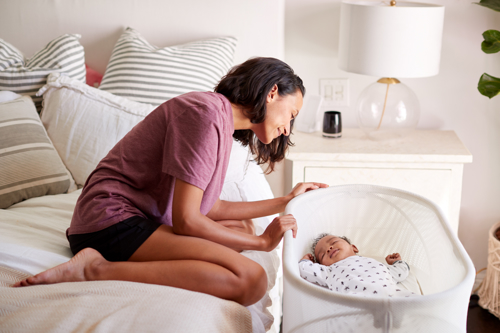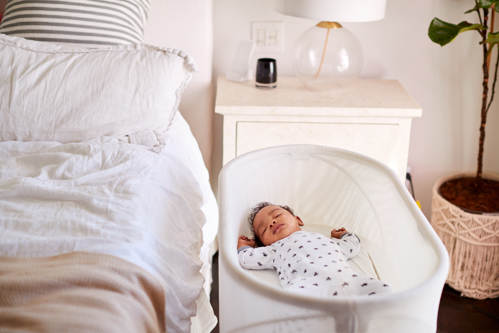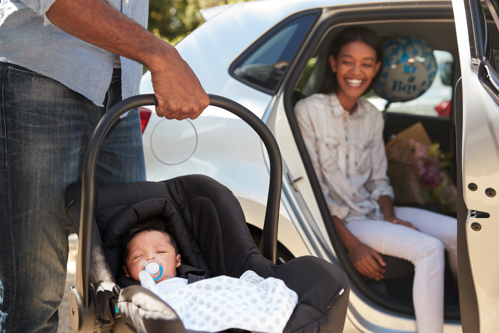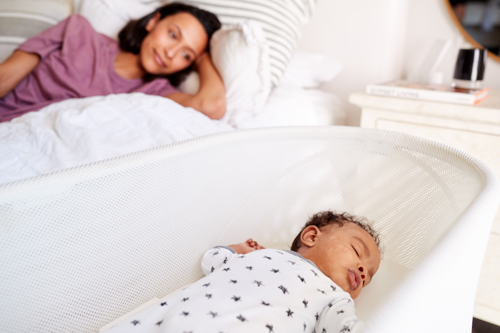Keeping children safe and well is the number one priority for every parent, carer and professional involved in a child’s life. Our constant vigilance allows for children to flourish in the best way possible. However, for our youngest children there are additional steps to take to ensure they continue to be safe even while sleeping.
Following safe sleeping guidance significantly reduces the risk of serious harm or death for very young children. Sudden Infant Death Syndrome (SIDS), also known as cot death, is the sudden, unexpected and unexplained death of an apparently health baby. It is most common in the first 6 months of life. In 2022, a report conducted by The National Child Mortality Database found that of all 6,503 infant and child deaths occurring between April 2019 and March 2021 in England, 64% had no immediately apparent cause. Nearly all of these (94%) unexplained deaths happened while the child was thought to be asleep.
Summer heat
It is advised that a room thermometer is used in any space a young child is sleeping. The target sleeping temperature for a room is around 16-20°c.
Where a room temperature is too low, additional lightweight bedding can be used however the child should be checked regularly to ensure their body temperature does not rise too high (despite the room being colder).
In summer, it may be difficult to maintain the temperature between 16-20°c. If the room where the baby sleeps is difficult to cool use lighter bedding and clothing and open the bedroom door and a window, if it is safe to do so. Baby sleep bags will have guidance on what tog to use for each season. It might be beneficial to use a fan to cool the room however ensure that it is not aimed directly onto the baby. It should be used to circulate and/or cool the air in the room and not the body.

If out-and-about in the heat, be sure not to cover prams with blankets or non-breathable materials as this can increase the temperature inside the pram significantly. The baby is then at risk of overheating and falling very unwell as a result. It is of course important to shade babies from the UV and sun rays, but this should be done with breathable, lightweight covers designed for this purpose, such as an umbrella or designated sunshade.
If a digital thermometer is not available, checking a baby’s temperature can be done by feeling their chest or the back of their neck and comparing this to the naturally cooler parts of a body, such as hands and feet. If the baby’s skin is hot or sweaty, remove one or more layers of bedclothes or bedding.
Positioning in bed
The safest sleeping position for a baby is on their back until they are old enough to roll over. For the first few times a baby rolls onto their tummy while sleeping the adult caring for them may want to roll the child back over onto their back. However, once the baby can move themselves from their back to their front and back again by themselves, they will be able to find their own sleeping position.
Bedding should be lightweight and designed for baby sleeping. Bedding should be firmly tucked in and blankets should never be used above shoulder height. Babies should be placed at the foot of their cot in the ‘feet-to-foot’ position so that they cannot move further down the bed and accidentally slip under the blankets. A sleep bag could also be used instead of blankets, this should be appropriately sized in comparison to baby weight and the right thickness (or ‘tog’) for the weather season.
Children do not need pillows or cushions to sleep with below aged around 18-24 months. Soft toys should also be avoided to ensure risks of suffocation are reduced.

Car seats
Car seats are designed to keep babies safe while travelling, not as a main sleeping place. Research published in 2016 by the University of Bristol looked at the health effects on babies of travelling in car seats. The study found pre-term and young babies may be at risk of breathing difficulties if travelling in an upright position in car seats for a long period of time.
Sleeping spaces for babies should always be a firm, flat surface. It may be unavoidable for a baby to fall asleep in their car seat if travelling. In those situations, the child should be taken out of the car seat as soon as arriving to the destination and placed on a firm, flat surface to sleep. Ideally an adult will travel in the back of the car next to the child and car seat and be able to monitor the child for any changes in their health or wellbeing.

Co-sleeping
Many parents and professionals will have their own views on co-sleeping arrangements. The Lullaby Trust, who advise on all things safe sleeping, have provided the following guidance on co-sleeping:
Co-sleeping with a baby is very dangerous if:
- anyone in the bed has recently drunk any alcohol
- anyone in the bed smokes
- anyone in the bed has taken any drugs or medication that make them feel sleepy
- the baby was born prematurely (before 37 weeks of pregnancy) or weighed under 2.5kg or 5½ lbs when they were born.
In these scenarios, it is always best to put baby in their own safe sleep space, such as a cot or Moses basket. Keeping the cot or Moses basket next to a main bed might make this easier.

Never fall asleep on a sofa or armchair with a baby. The risk of SIDS is 50 times higher for babies when they sleep on a sofa or armchair with an adult. They are also at risk of accidental death as they can easily slip into a position where they are trapped and can’t breathe.